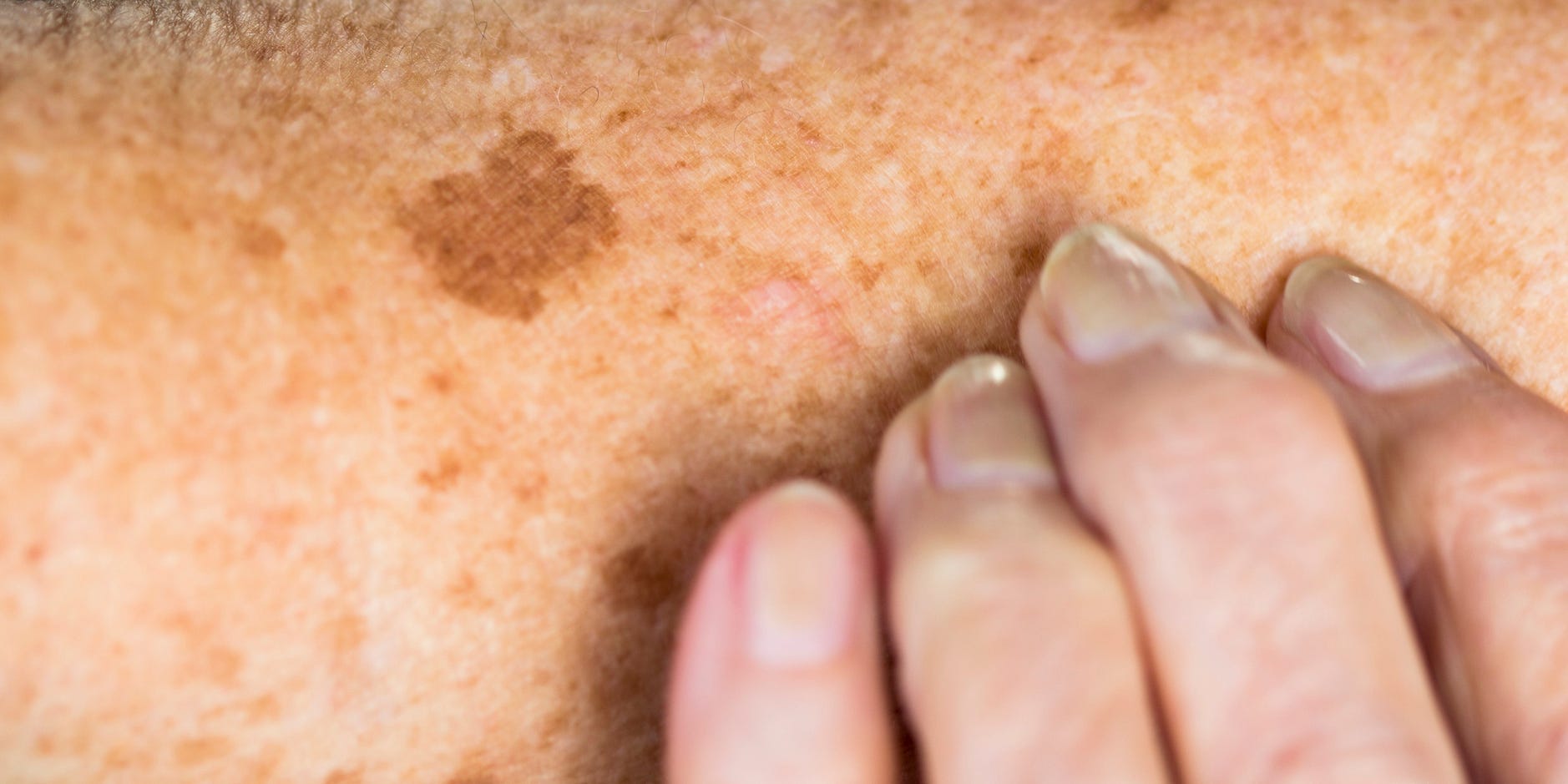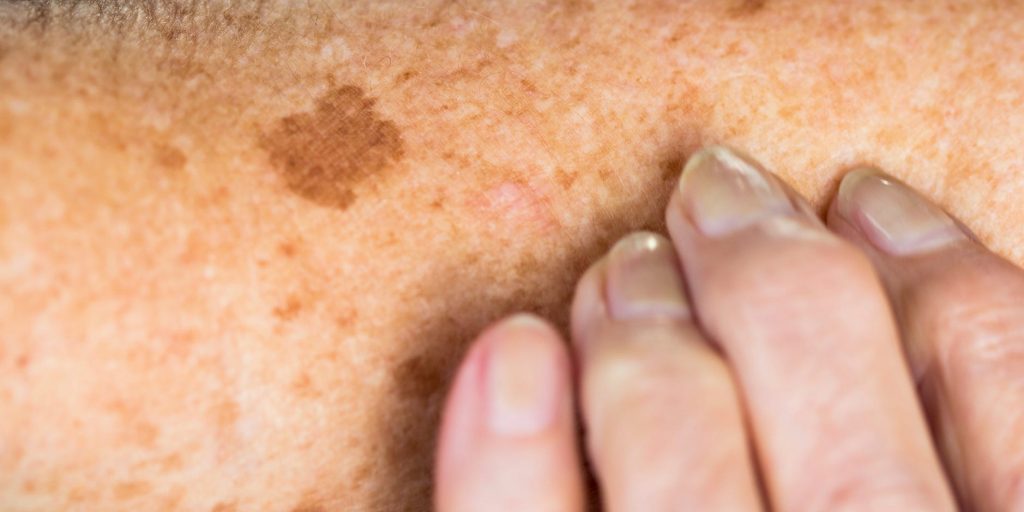
CRISTINA PEDRAZZINI/SCIENCE PHOTO LIBRARY/Getty Images
- Hyperpigmentation can be caused by skin damage, sun exposure, and pregnancy.
- To fight it, you need to use ingredients like niacinamide, hydroquinone, and retinol.
- These ingredients help reduce inflammation and produce new skin cells for a smoother complexion.
- Visit Insider's Health Reference library for more advice.
If you've looked in the mirror and noticed dark spots on your skin, then you may have some hyperpigmentation. The spots can be small or large and often show up on your face, neck, hands, and body folds.
Hyperpigmentation is a common condition that can be caused by a number of things including sun exposure, acne, and hormonal changes. It's usually harmless, but you can have it removed if you find it unsightly..
What causes hyperpigmentation?
Hyperpigmentation happens when your body produces extra melanin, the brown pigment responsible for skin color. Most often, hyperpigmentation is caused by:
- Skin damage or injury: Some dark patches are known as post-inflammatory hyperpigmentation, which is usually a side effect of a skin condition, like eczema. These conditions damage the skin which can lead to extra, leftover pigment. Darker-skinned people are more likely to have this type of hyperpigmentation because of their higher concentration of melanin. "We commonly see this after acne, particularly acne that gets picked," says Hadley King, MD, a board-certified dermatologist and clinical instructor at the Weill Medical College of Cornell University.
- Melasma: Melasma is another form of hyperpigmentation that causes brown or gray patches to appear on your face. It can be caused by sun exposure or a genetic predisposition, King says. The changing hormone levels in pregnancy can also cause melasma – up to 50% of pregnant people will get it. Melasma may naturally fade a few months after pregnancy but in some cases, you may need treatment to get rid of it.
- Sun exposure: Lentigines, or liver spots, are a type of hyperpigmentation that occur when your skin is exposed to too much sunlight. "Lighter skin types are more vulnerable to solar lentigines," King says, and as many as 90% of white people over 60 will have sun-related hyperpigmentation.
How to get rid of hyperpigmentation
It's a three-step process to get rid of hyperpigmentation, says Joshua Zeichner, MD, a board-certified dermatologist and the director of cosmetic and clinical research at Mount Sinai Hospital.
You need to reduce skin inflammation, block the production of melanin, and increase skin cell turnover to help shed the cells that contain extra pigment, Zeichner says.
The following ingredients can all help with the symptoms of hyperpigmentation when you apply them directly to the affected areas of skin.
Ingredients to reduce skin inflammation
Zeichner recommends looking for skin products that contain anti-inflammatory ingredients to help soothe skin, including:
Niacinamide: Niacinamide is a form of vitamin B3 that helps to repair damaged skin cells. One small 2013 study on women found that using a moisturizer with niacinamide twice per day significantly reduced hyperpigmentation over eight weeks of treatment. You can find niacinamide in over-the-counter products like Cerave PM Face Moisturizer.
Licorice root: Licorice root has anti-inflammatory properties and may help calm skin irritated by acne and other skin conditions. Using products containing licorice may also soothe hyperpigmented skin, though research is still limited. Therefore, consult a dermatologist if you're unsure about this ingredient.
Ingredients to stop the production of melanin
Hydroquinone: Hydroquinone is a compound that can lighten skin and is generally considered to be the "gold standard" of hyperpigmentation treatment. It works by reducing the melanin production in your skin, leaving it with less pigment, King says.
You can find hydroquinone over the counter or get a prescription for stronger concentrations from your dermatologist.
Kojic acid: Kojic acid is a chemical produced from some types of fungi and is used as a skin-lightening ingredient for hyperpigmented skin, King says. Kojic acid works by blocking an amino acid called tyrosine from forming in your skin, which then prevents melanin production.
Kojic acid is available over the counter, and you may find it combined with hydroquinone in many skin products.
Ingredients to increase skin cell turnover
Retinol: Retinol is a compound derived from vitamin A that acts as a chemical exfoliant, causing your skin to create new cells more quickly and get rid of older cells that may be holding extra pigment. Studies show that using retinol can help decrease hyperpigmentation and even out skin tone.
There are many over the counter skin products containing retinol, or you can opt for higher prescription concentrations.
Glycolic acid: Glycolic acid is another chemical exfoliant that's derived from sugar cane. Research shows that glycolic acid may help improve hyperpigmentation by causing the top, damaged layer of skin to peel off.
You can buy glycolic acid over the counter as a serum, or visit a dermatologist to get a more intense glycolic acid chemical peel.
Throughout all of these treatments, you will need to use sun protection, King says, as sun exposure can damage skin, trigger melanin production, and reverse your results.
You can use many of these treatments on a daily basis, King says, but you shouldn't continue treatment on your own for more than three months. If you still aren't getting the results you want after this time, you should see a dermatologist.
Insider's takeaway
Hyperpigmentation is a common skin problem that can be treated at home with several over-the-counter remedies, along with sun protection. If home treatments aren't working for you, reach out to a board-certified dermatologist, who may be able to offer other treatment options.
